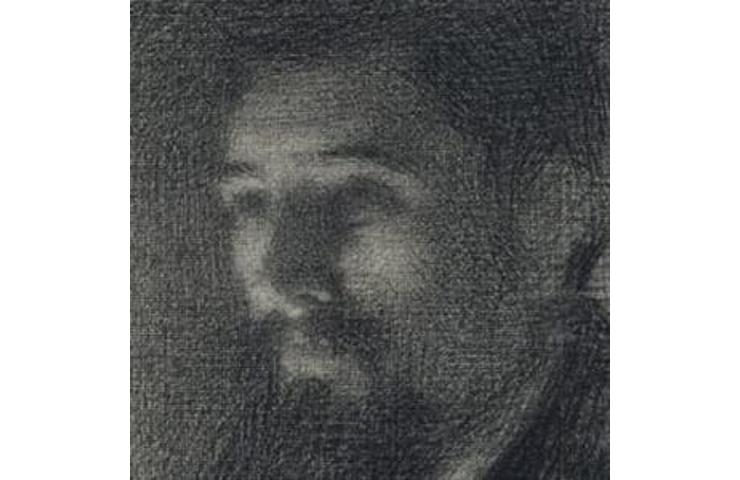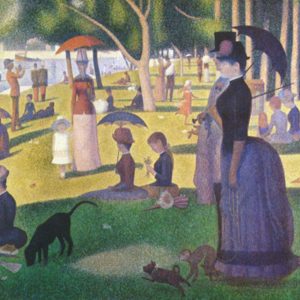No products in the cart.

Painter (1859–1891)
The artist Georges Seurat is best known for originating the Pointillist method of painting, using small dot-like strokes of color in works such as “A Sunday on La Grande Jatte.”
Synopsis
The artist Georges Seurat was born on December 2, 1859, in Paris, France. After training at the École des Beaux-Arts, he broke free of tradition. Taking his technique a step beyond Impressionism, he painted with small strokes of pure color that seem to blend when viewed from a distance. This method, called Pointillism, is showcased in major works of the 1880s such as “A Sunday on La Grande Jatte.” Seurat’s career was cut short when he died of illness on March 29, 1891, in Paris.
Early Life
Georges Pierre Seurat was born on December 2, 1859, in Paris, France. His father, Antoine-Chrysostome Seurat, was a customs official who was often away from home. Seurat and his brother, Emile, and sister, Marie-Berthe, were raised primarily by their mother, Ernestine (Faivre) Seurat, in Paris.
Seurat received his earliest art lessons from an uncle. He began his formal art education around 1875, when he began attending a local art school and studying under sculptor Justin Lequien.
Artistic Training and Influences
From 1878 to 1879, Georges Seurat was enrolled at the famous École des Beaux-Arts in Paris, where he received training under artist Henri Lehmann. However, feeling frustrated with the school’s strict academic methods, he left and continued to study on his own. He admired the new large-scale paintings of Puvis de Chavannes, and in April 1879, he visited the Fourth Impressionist Exhibition and saw radical new works by Impressionist painters Claude Monet and Camille Pissarro. The Impressionists’ ways of conveying light and atmosphere influenced Seurat’s own thinking about painting.
Seurat was also interested in the science behind art, and he did a good deal of reading on perception, color theory and the psychological power of line and form. Two books that affected his development as an artist were Principles of Harmony and Contrast of Colors, written by chemist Michel-Eugène Chevreul, and Essay on the Unmistakable Signs of Art, by painter/writer Humbert de Superville.
New Approaches and Neo-Impressionism
Seurat exhibited a drawing in the annual Salon, a major state-sponsored exhibition, for the first time in 1883. However, when he was rejected by the Salon the following year, he banded together with other artists to found the Salon des Indépendants, a more progressive series of unjuried exhibitions.
In the mid-1880s, Seurat developed a style of painting that came to be called Divisionism or Pointillism. Rather than blending colors together on his palette, he dabbed tiny strokes or “points” of pure color onto the canvas. When he placed colors side by side, they would appear to blend when viewed from a distance, producing luminous, shimmering color effects through “optical mixing.”
Seurat continued the work of the Impressionists, not only through his experiments with technique, but through his interest in everyday subject matter. He and his colleagues often took inspiration from the streets of the city, from its cabarets and nightclubs, and from the parks and landscapes of the Paris suburbs.
Major Works
Seurat’s first major work was “Bathers at Asnières,” dated 1884, a large-scale canvas showing a scene of laborers relaxing alongside a river outside Paris. “Bathers” was followed by “A Sunday on La Grande Jatte” (1884-86), an even larger work depicting middle-class Parisians strolling and resting in an island park on the Seine River. (This painting was first exhibited in the Eighth Impressionist Exhibition in 1886.) In both works, Seurat tried to give modern-day figures a sense of significance and permanence by simplifying their forms and limiting their details; at the same time, his experimental brushwork and color combinations kept the scenes vivid and engaging.
Seurat painted female subjects in “The Models” of 1887-88 and “Young Woman Powdering Herself” of 1888-89. In the late 1880s, he created several scenes of circuses and nightlife, including “Circus Sideshow” (1887-88), “Le Chahut” (1889-90) and “The Circus” (1890-91). He also produced a number of seascapes of the Normandy coast, as well as a number of masterful black-and-white drawings in Conté crayon (a mix of wax and graphite or charcoal).
Death and Legacy
Seurat died on March 29, 1891, in Paris, after a brief illness that was most likely pneumonia or meningitis. He was buried in the Père Lachaise cemetery in Paris. He was survived by his common-law wife, Madeleine Knobloch; their son, Pierre-Georges Seurat, died a month later.
Seurat’s paintings and artistic theories influenced many of his contemporaries, from Paul Signac to Vincent van Gogh to Symbolist artists. His monumental “A Sunday on La Grande Jatte,” now at the Art Institute of Chicago, is considered an iconic work of late 19th century art. This painting, and Seurat’s career, inspired Steven Sondheim to write the musical Sunday in the Park with George (1984). The work is also featured in the John Hughes film Ferris Bueller’s Day Off (1986).



